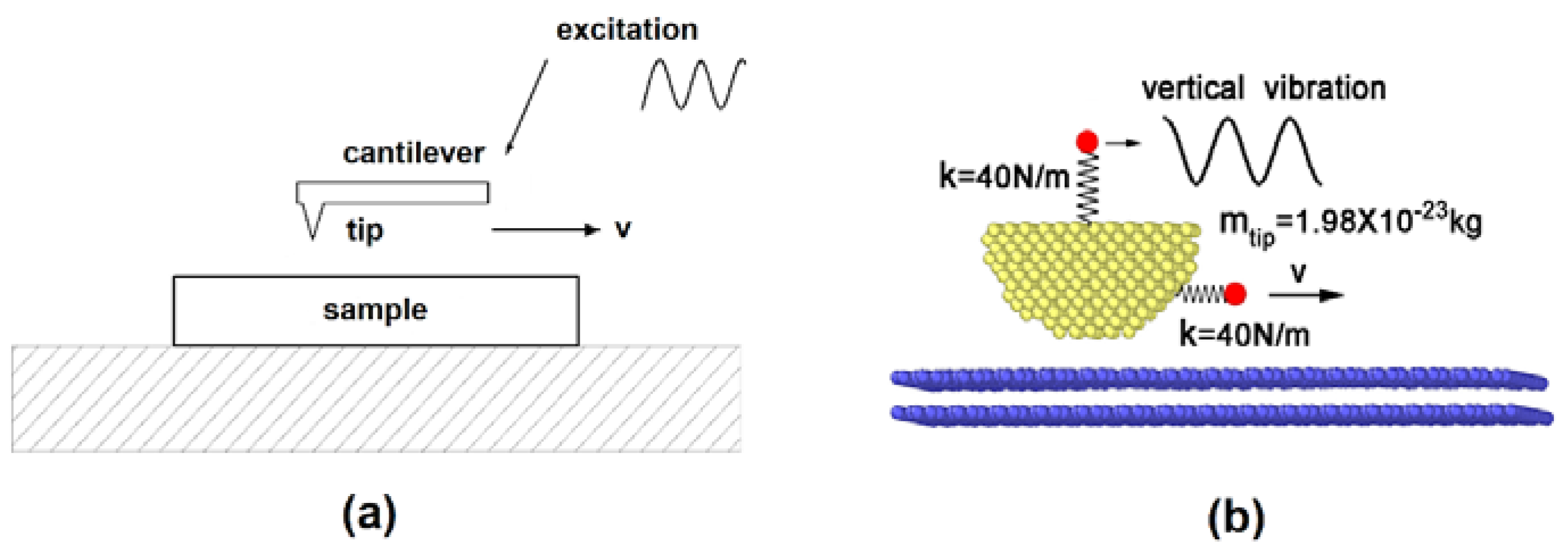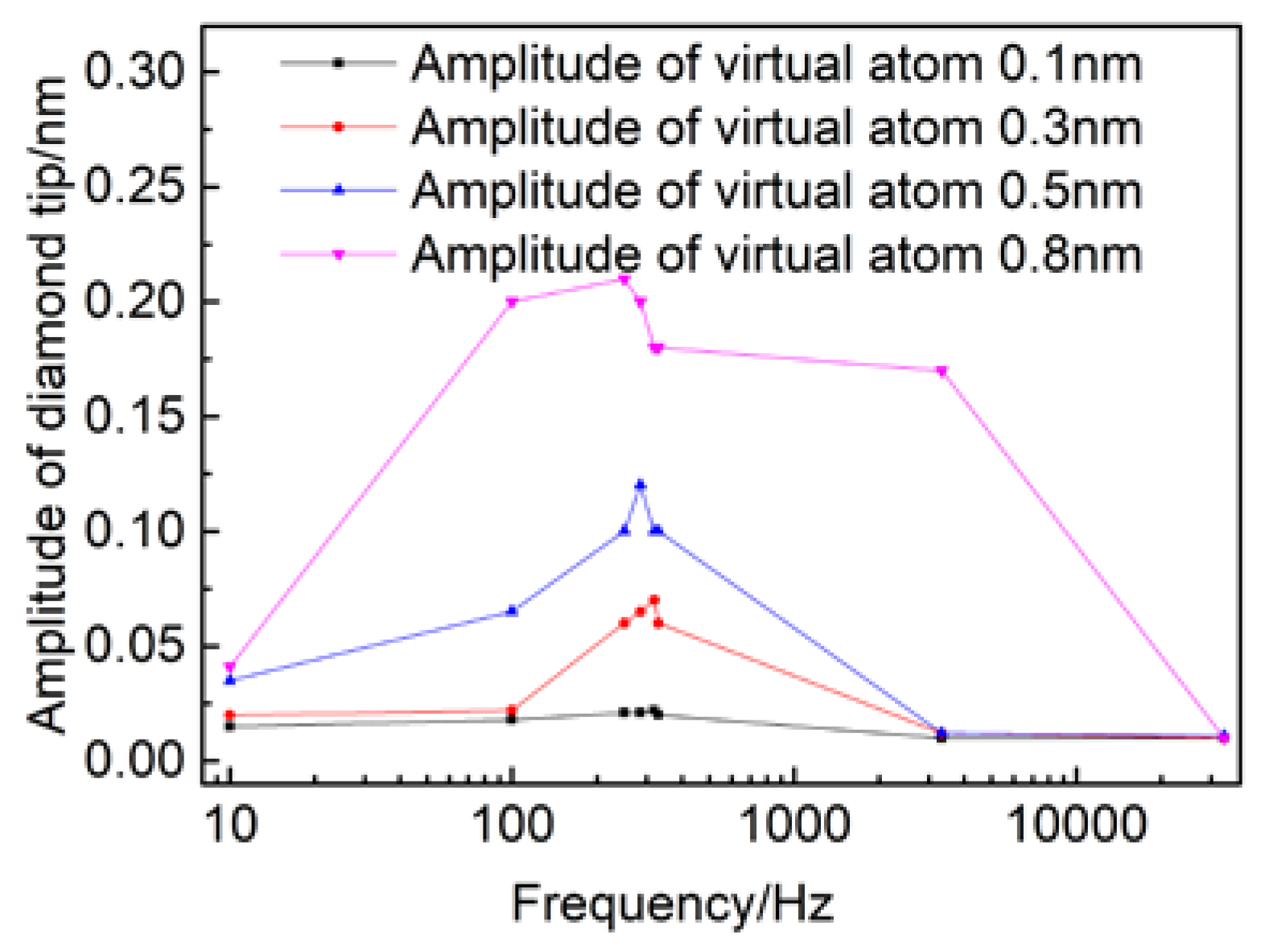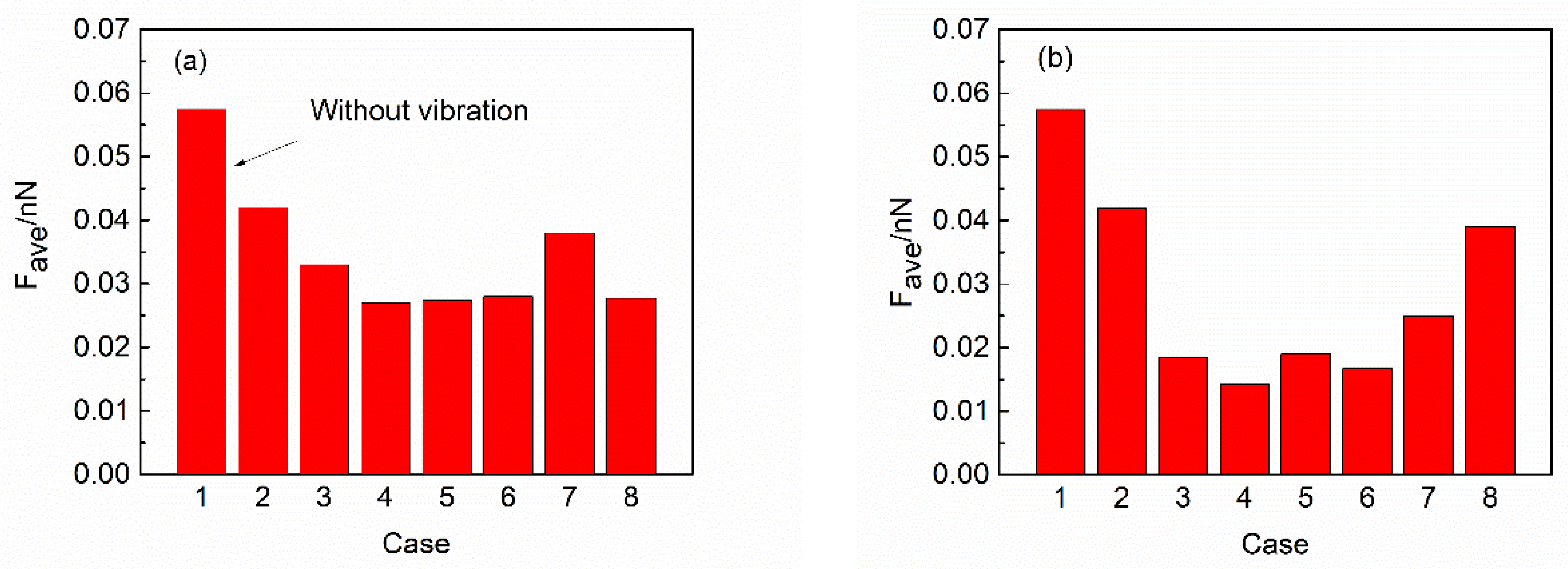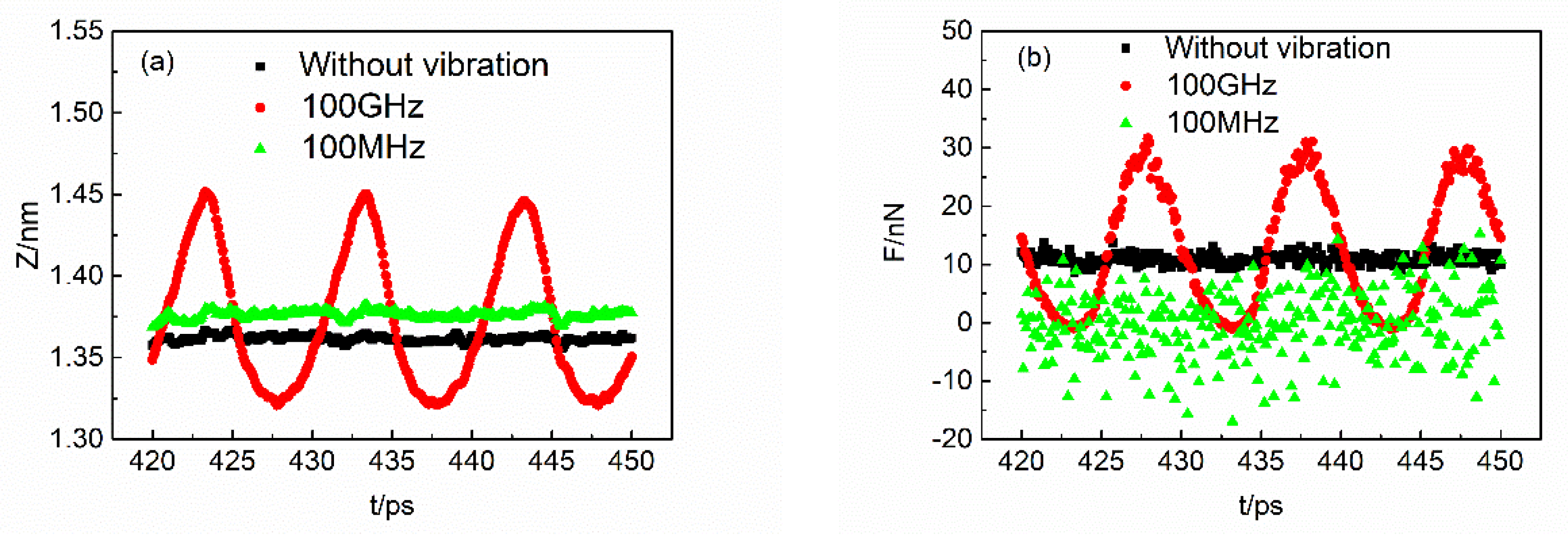The Influence of Vertical Vibration on Nanoscale Friction: A Molecular Dynamics Simulation Study
Abstract
:1. Introduction
2. Simulation Model
3. Results and Discussion
4. Conclusions
Acknowledgments
Author Contributions
Conflicts of Interest
References
- Berman, D.; Erdemir, A.; Zinovev, A.V.; Sumant, A.V. Nanoscale friction properties of graphene and graphene oxide. Diam. Relat. Mater. 2015, 54, 91–96. [Google Scholar] [CrossRef]
- Li, Q.Y.; Liu, X.Z.; Kim, S.P.; Shenoy, V.B.; Sheehan, P.E.; Robinson, J.T.; Carpick, R.W. Fluorination of Graphene Enhances Friction Due to Increased Corrugation. Nano Lett. 2014, 14, 5212–5217. [Google Scholar] [CrossRef] [PubMed]
- Ko, J.H.; Kwon, S.; Byun, I.S.; Choi, J.S.; Park, B.H.; Kim, Y.H.; Park, J.Y. Nanotribological Properties of Fluorinated, Hydrogenated, and Oxidized Graphenes. Tribol. Lett. 2013, 50, 137–144. [Google Scholar] [CrossRef]
- Men, X.H.; Zhang, Z.Z.; Yang, J.; Zhu, X.T.; Wang, K.; Jiang, W. Effect of Different Functional Carbon Nanotubes on the Tribological Behaviors of Poly (Furfuryl Alcohol)-Derived Carbon Nanocomposites. Tribol. Trans. 2011, 54, 265–274. [Google Scholar] [CrossRef]
- Zhou, M.; Liu, K.; Wan, J.; Li, X.; Jiang, K.L.; Zeng, H.B.; Zhang, X.J.; Meng, Y.G.; Wen, S.Z.; Zhu, H.W.; Tian, Y. Anisotropic interfacial friction of inclined multiwall carbon nanotube array surface. Carbon 2012, 50, 5372–5379. [Google Scholar] [CrossRef]
- Dickrell, P.L.; Sinnott, S.B.; Hahn, D.W.; Raravikar, N.R.; Schadler, L.S.; Ajayan, P.M.; Sawyer, W.G. Frictional anisotropy of oriented carbon nanotube surfaces. Tribol. Lett. 2005, 18, 59–62. [Google Scholar] [CrossRef]
- Lucas, M.; Zhang, X.H.; Palaci, I.; Klinke, C.; Tosatti, E.; Riedo, E. Hindered rolling and friction anisotropy in supported carbon nanotubes. Nat. Mater. 2009, 8, 876–881. [Google Scholar] [CrossRef] [PubMed]
- Greiner, C.; Felts, J.R.; Dai, Z.T.; King, W.P.; Carpick, R.W. Controlling Nanoscale Friction through the Competition between Capillary Adsorption and Thermally Activated Sliding. ACS Nano 2012, 6, 4305–4313. [Google Scholar] [CrossRef] [PubMed]
- Tsai, P.C.; Jeng, Y.R.; Mao, C.P.; Wu, K.T.; Hong, F.C.N. Effects of surface morphology, size effect and wettability on interfacial adhesion of carbon nanotube arrays. Thin Solid Films 2013, 545, 401–407. [Google Scholar] [CrossRef]
- Carpick, R.W. Controlling Friction. Science 2006, 313, 184–185. [Google Scholar] [CrossRef] [PubMed]
- Gao, J.; Luedtke, W.D.; Landman, U. Friction Control in Thin-Film Lubrication. J. Phys. Chem. B 1998, 102, 5033–5037. [Google Scholar] [CrossRef]
- Heuberger, M.; Drummond, C.; Israelachvili, J. Coupling of Normal and Transverse Motions during Frictional Sliding. J. Phys. Chem. B 1998, 102, 5038–5041. [Google Scholar] [CrossRef]
- Tshiprut, Z.; Filippov, A.E.; Urbakh, M. Tuning Diffusion and Friction in Microscopic Contacts By Mechanical Excitations. Phys. Rev. Lett. 2005, 95, 016101. [Google Scholar] [CrossRef] [PubMed]
- Guerra, R.; Vanossi, A.; Urbakh, M. Controlling microscopic friction through mechanical oscillations. Phys. Rev. E 2008, 78, 036110. [Google Scholar] [CrossRef] [PubMed]
- Ma, M.; Sokolov, I.M.; Wang, W.; Filippov, A.E.; Zheng, Q.; Urbakh, M. Diffusion through Bifurcations in Oscillating Nano- and Microscale Contacts: Fundamentals and Applications. Phys. Rev. X 2015, 5, 031020. [Google Scholar] [CrossRef]
- Capozza, R.; Vanossi, A.; Vezzani, A.; Zapperi, S. Suppression of Friction by Mechanical Vibrations. Phys. Rev. Lett. 2009, 103, 085502. [Google Scholar] [CrossRef] [PubMed]
- Capozza, R.; Vanossi, A.; Vezzani, A.; Zapperi, S. Triggering Frictional Slip by Mechanical Vibrations. Tribol. Lett. 2012, 48, 95–102. [Google Scholar] [CrossRef]
- Socoliuc, A.; Gnecco, E.; Maier, S.; Pfeiffer, O.; Baratoff, A.; Bennewitz, R.; Meyer, E. Atomic-scale control of friction by actuation of nanometer-sized contacts. Science 2006, 313, 207–210. [Google Scholar] [CrossRef] [PubMed]
- Guo, Y.; Wang, Z.; Qu, Z.; Braiman, Y. Atomic-scale friction control by vibration using friction force microscope. Control Eng. Pract. 2011, 19, 1387–1397. [Google Scholar] [CrossRef]
- Fajardo, O.Y.; Gnecco, E.; Mazo, J.J. Out-of-plane and in-plane actuation effects on atomic-scale friction. Phys. Rev. B 2014, 89, 075423. [Google Scholar] [CrossRef]
- Roth, R.; Fajardo, O.Y.; Mazo, J.J.; Meyer, E.; Gnecco, E. Lateral vibration effects in atomic-scale friction. Appl. Phys. Lett. 2014, 104, 083103. [Google Scholar] [CrossRef] [Green Version]
- Hu, X.; Egberts, P.; Dong, Y.; Martini, A. Molecular dynamics simulation of amplitude modulation atomic force microscopy. Nanotechnology 2015, 26, 235705. [Google Scholar] [CrossRef] [PubMed]
- Shimizu, J.; Eda, H.; Yoritsune, M.; Ohmura, E. Molecular dynamics simulation of friction on the atomic scale. Nanotechnology 1998, 9, 118–123. [Google Scholar] [CrossRef]
- Stuart, S.J.; Tutein, A.B.; Harrison, J.A. A reactive potential for hydrocarbons with intermolecular interactions. J. Chem. Phys. 2000, 112, 6472–6486. [Google Scholar] [CrossRef]
- Neek-Amal, M.; Peeters, F.M. Nanoindentation of a circular sheet of bilayer graphene. Phys. Rev. B 2010, 81, 235421. [Google Scholar] [CrossRef]
- Reinstädtler, M.; Rabe, U.; Goldade, A.; Bhushan, B.; Arnold, W. Investigating ultra-thin lubricant layers using resonant friction force microscopy. Tribol. Int. 2005, 38, 533–541. [Google Scholar] [CrossRef]
- Liu, L.; Zhang, W.H. Frequency variety analysis and equivalent algorithm of metal spring stiffness. J. Traffic Transp. Eng. 2007, 7, 24–27. [Google Scholar]
- Li, Q.Y.; Dong, Y.L.; Perez, D.; Martini, A.; Carpick, R.W. Speed Dependence of Atomic Stick-Slip Friction in Optimally Matched Experiments and Molecular Dynamics Simulations. Phys. Rev. Lett. 2011, 106, 126101. [Google Scholar] [CrossRef] [PubMed]





© 2018 by the authors. Licensee MDPI, Basel, Switzerland. This article is an open access article distributed under the terms and conditions of the Creative Commons Attribution (CC BY) license (http://creativecommons.org/licenses/by/4.0/).
Share and Cite
Cheng, Y.; Zhu, P.; Li, R. The Influence of Vertical Vibration on Nanoscale Friction: A Molecular Dynamics Simulation Study. Crystals 2018, 8, 129. https://doi.org/10.3390/cryst8030129
Cheng Y, Zhu P, Li R. The Influence of Vertical Vibration on Nanoscale Friction: A Molecular Dynamics Simulation Study. Crystals. 2018; 8(3):129. https://doi.org/10.3390/cryst8030129
Chicago/Turabian StyleCheng, Yang, Pengzhe Zhu, and Rui Li. 2018. "The Influence of Vertical Vibration on Nanoscale Friction: A Molecular Dynamics Simulation Study" Crystals 8, no. 3: 129. https://doi.org/10.3390/cryst8030129




